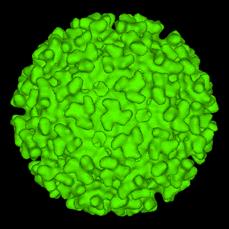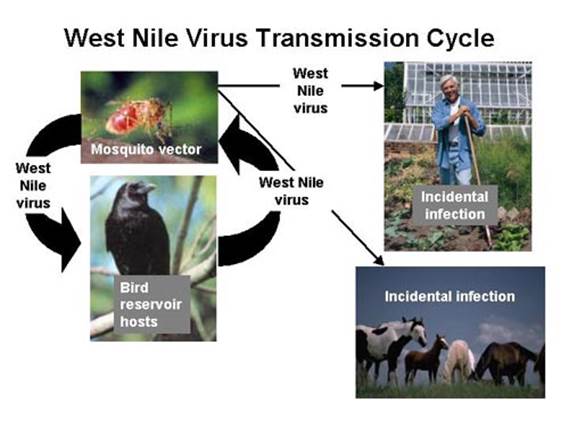What are WNV and EEE? (Biological Basis)
Eastern Equine Encephalitis (EEE) and West Nile Virus (WNV) are single stranded RNA arboviruses .
.

Figure 3: Computer-generated model of EEE surface based on cryo-electron microscopy.
(http://www.cdc.gov/ncidod/dvbid/arbor/images/alphavir.gif)
For more information on the spread of West Nile Virus into the western hemisphere, see: http://www.nejm.org/doi/full/10.1056/NEJMp048261, and
http://www.nejm.org/doi/full/10.1056/NEJMp1210537Typical Human Transmission
Mosquitoes can become infected with EEE or WNV from feeding on infected birds that are reservoirs for both viruses. Infected mosquitoes transmit the disease directly to humans through biting.
for both viruses. Infected mosquitoes transmit the disease directly to humans through biting.
Figure 4: The Transmission Cycle of West Nile Virus and Eastern Equine Encephalitis
(http://nationalatlas.gov/articles/biology/a_wnv.html).
Through an enzootic cycle involving mosquitoes and birds, the viruses are able to survive in nature, which facilitates ongoing transmission from infected birds to uninfected mosquitoes, which can then be transmitted to humans (Figure 4).
involving mosquitoes and birds, the viruses are able to survive in nature, which facilitates ongoing transmission from infected birds to uninfected mosquitoes, which can then be transmitted to humans (Figure 4).
Additional Modes of Transmission
RK:I think this section would have fit better at the end of all the human infection-related subsections. It talks about a lot of rare events, but there is no numerical evidence (incidence or prevalence) to back up some of the facts.
Several rare reports describe the vertical transmission of both viruses from pregnant or breastfeeding women to their babies. The possibility for transmission between humans through blood transfusions or organ transplants also exists.
Mosquitos have been documented to occasionally transmit these infections to horses and other animals. Although there has never been documented transmission from birds to people, dead birds have the potential to transmit the viruses to humans if handled with bare hands. Therefore, special precautions need to be taken when handling dead animals, especially birds that may be infected with WNV or EEE.
For additional information on transmission of WNV to horses:
http://www.sciencedirect.com/science/article/pii/S0378113513004124
Infection
Upon transmission, viral replication begins at the bite site. The virus then spreads to the lymph nodes and blood stream. The infection can also spread to the neurons of the central nervous system (especially in dark matter), which may increase blood-brain barrier permeability and cause encephalitis or meningitis, some of the most serious symptoms associated with these viruses.
The following video shows the sequence of how a virus enters a host cell to replicate its DNA. This is a general sequence of events, not specific to WNV or EEE, but is an excellent model for how those viruses replicate as well.
Simple viral replication video (34 seconds):
Symptom Development
Approximately 80% of infected individuals will experience relatively mild symptoms or be asymptomatic. However, development of mild and severe symptoms may occur 3 to 14 days after a bite from an infected mosquito. Table 1 summarizes the symptoms of WNV and EEE, and table 2 summarizes the incidence of symptom severity:
Table 1: Possible mild and severe symptoms of WNV and EEE.
|
|
West Nile Virus |
Eastern Equine Encephalitis |
|---|---|---|
|
Mild Symptoms |
|
|
|
Severe Symptoms |
|
|
For further reading on the symptoms of WNV, read:
http://www.nejm.org/doi/full/10.1056/NEJM200106143442401#t=article
For further reading on the symptoms of EEE, read:
http://www.nejm.org/doi/full/10.1056/NEJMoa1212628#t=article
Table 2: Incidence of West Nile Virus by Degree of Severity
|
West Nile Virus |
|
|---|---|
|
No Symptoms |
70-80% |
|
Mild Symptoms |
20% |
|
Severe Symptoms |
1% |
|
Deaths |
10% |
EEE shares a similar distribution of disease severity, with most infected people showing no apparent symptoms. However, death occurs in approximately 33% of patients. 35-50% of those who survive the disease will have permanent neurological disorder.
For further reading on the infection and pathogenesis of WNV: http://www.mdpi.com/1999-4915/5/11/2856



